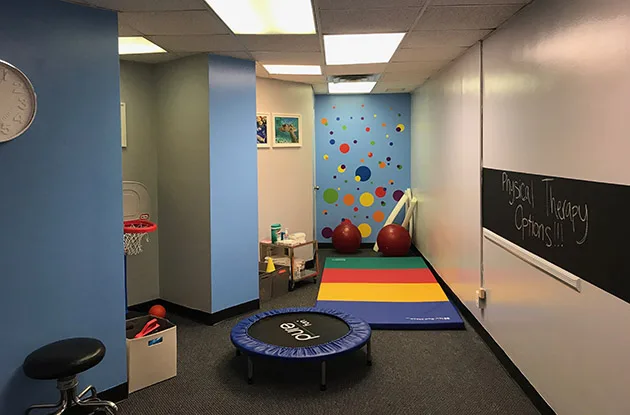An occupational therapist shares some tricks of the trade for helping kids master age-appropriate self-care tasks like dressing themselves, using zippers and buttons, tying their own shoes, and using a knife and fork.
Another mom sat across from me, both of us perched on the child-sized chairs of my occupational therapy room, telling me about her daughter. Kathleen* (not her real name) was a smart and spunky 8-year-old whose difficulties with fine motor skills were getting in the way at school. Also, the mother added, looking a little embarrassed, “She still needs help with snaps and zippers. And she can't tie shoes. At all.”
Testing showed that Kathleen had some delays in fine motor skills, so I began to see her regularly. Her progress was quick, and after a couple of weeks, it was time to tie shoes. “I've tried!” Kathleen told me. “I'll never be able to do it.”
We sat down with a big sneaker, and I demonstrated tying, slowly, using simple phrases to label my actions. Then I let Kathleen try it, step by step. In 15 minutes she was tying like a pro.
The next week Kathleen proudly announced that she had gotten new shoes and was tying them all by herself. Her mother said, “I asked her how she could tie so well when she could never do it before.” Kathleen had answered, “No one ever taught me right before.”
As a pediatric occupational therapist, I have met a lot of Kathleens — kids of all ages with no specific disability who have not mastered the everyday tasks of dressing and feeding. Some have trouble with fine motor skills, while others have difficulties with coordination, strength, visual processing, attention, or the sequencing of steps. Still others just have a hard time tolerating the frustration involved in learning something new.
The rehabilitation specialty of occupational therapy uses purposeful and meaningful activities to help people gain skills for independence. With kids, this often involves working on dressing and feeding. Occupational therapists do know some handy teaching strategies, but helping a struggling child learn to dress and feed herself usually does not require professional expertise. In many cases, all you need are age-appropriate expectations and a few tricks of the trade.
What to Expect
There is a wide range of ages at which dressing and feeding skills emerge; kids tend to have their own timetables for these things. For this reason, comparing your child to siblings or to the handful of children you personally know may not be as helpful as looking at developmental norms based on a wider sampling of children. Unfortunately, not all parenting books and websites include information about self-care skills. For questions in this specific area, the What to Expect books are helpful, as is the series by Louise Bates Ames (Your One-Year-Old: The Fun-Loving, Fussy 12- to 24-Month-Old; Your Two-Year-Old: Terrible or Tender, and more). Perhaps even better than books, your child's own teacher, childcare provider, or pediatrician can be a wonderful source of information about typical child development and behavior.
Helping Children Help Themselves
When a child is struggling with a task, often a parent's first instinct is to do it for him. Taking care of basic needs like feeding and dressing, after all, is a fundamental way parents nurture their children; it is only natural to want to do these things for your child. But we all know that helping a child help himself is wiser in the long run.
Break it down.
If your child is having difficulty mastering any self-care skill, take a minute to break down the task. Perform the task yourself, slowly, labeling the steps involved. To use a spoon, for example, a child must hold the spoon tightly enough, scoop food, bring the spoon to mouth without turning it over, close lips around it, and pull the spoon out without letting go.
Give the right help at the right time.
Which part of the process is causing problems for your child? Help him with just that step and nothing more. As he begins to master the step, give less and less help with it. For example, maybe your toddler is able to scoop food with a spoon but has difficulty getting it into his mouth. He needs you to help guide the spoon at just one brief point in the process of eating, no more. As he improves his aim with the spoon, fade your assistance to a light touch or to words of encouragement.
Try backward chaining for tricky tasks.
A new skill that involves a lot of coordination, like buttoning, can be overwhelming to some children. If they try to tackle the whole task at once, they may fail and give up. Sometimes, it is helpful to have your child begin by performing only the last step. When buttoning, for example, you might do almost the entire task, then let your child pinch the button and give it the final tug that fastens it. When she is able to do that, go backwards in the chain of steps, so that she is performing the last two steps. You might put the button part way into the hole and have your child grasp both the cloth and the button to fasten it. Gradually continue adding steps until she is doing the entire task. By having her begin by doing the final steps, rather than the first, she gets to finish the task and feel the pride of achievement as you say, “Look! You did it!”
Use play to work on skill-building.
Ask yourself what ability your child needs to perform a difficult task. Does he need greater strength, more dexterity, or improved sequencing skills? A preschooler who cannot master buttons, for example, may need to perfect his pincer grasp. He can do this by playing with eyedroppers in the bathtub, popping sheets of packing bubbles, or squishing balls of play dough into flat “cookies.” An older child who lacks the coordination needed for shoe-tying might benefit from crafts or construction toys that require the cooperative use of two hands. Rest assured, whatever ability is lacking, there is a playful, engaging way to develop it.
Make things easier for a while.
As your child works on building the skills to allow her to perform self-care tasks, you can help her be as independent as possible by adapting materials or routines so that she has some opportunities to do things for herself. Baggy t-shirts, pants with elastic waists, and Velcro shoes may not be too fashionable for adults, but they are just fine for a 5-year-old. Consider a poncho for a little girl who has trouble putting on a coat. How about a pull-over fleece for the boy who cannot use a zipper? Think about ways to make a healthy meal from foods that can be finger-fed. Your efforts mean a lot when they help your child feel successful and competent.
Know when to ask for help.
If your child is experiencing lags in self-care skills that are having a negative impact on his daily life and self-esteem, it may be wise to get some help. Generally, a developmental lag of 25 percent or more can be considered significant. For example, if your child is 36 months old and has a delay of 9 months (which is 25 percent of 36), the lag might be considered significant, particularly if it is consistent with a pattern of delay in other areas, such as gross and fine motor skills and language development. Pediatricians and teachers can offer suggestions for working on your own to promote your child's development, or they may recommend that you seek out the assistance of an occupational therapist or other professional.
Respecting Kids' Independence
Most children have a strong desire to do things for themselves. This craving for independence is a gift that will enable your child to take care of himself in the world. Unfortunately, the drive for independence in dressing and feeding sometimes gets quashed by the realities of daily life. Let's face it, parents don't always have time to let their toddler feed herself, and not everyone is comfortable allowing their preschooler to walk out the front door with his pants on backwards. It's important, though, to respect children's need to do things for themselves by giving them extra time to practice and the freedom to make mistakes. And remember to equip yourself with those standby parenting tools — patience, tolerance, and perhaps most of all, a sense of humor.





















